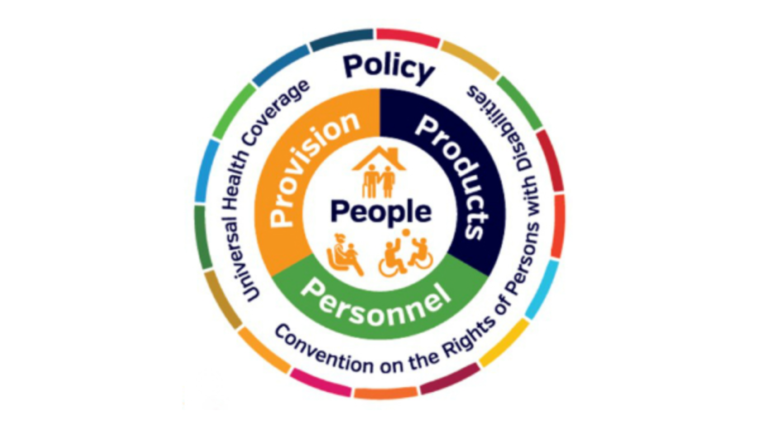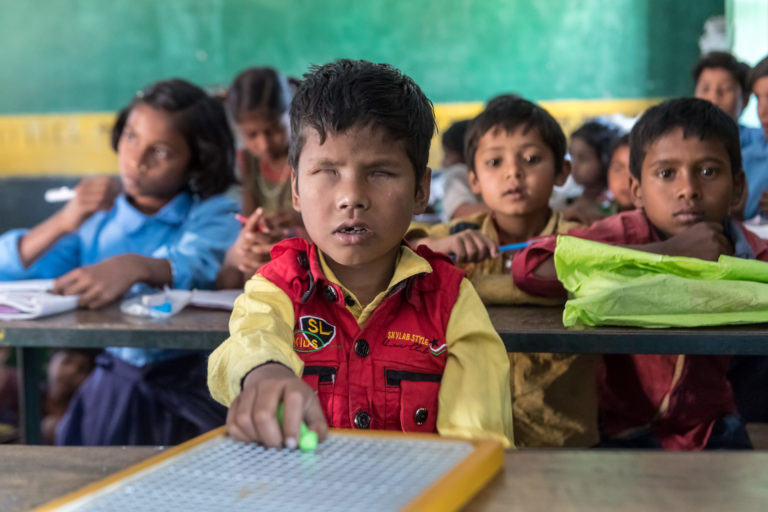How Can Technology Assist Children with Developmental Disabilities?

Share this step
Assistive products
Assistive products are any external product (including devices, equipment, instruments and software) that maintain or improve an individual’s functioning and independence, and thereby promote their wellbeing. These products can be specially produced or may be generally available.
Related services and systems include referral, assessment, prescriptions, funding, ordering, product fitting and training of the child in the use of the assistive product. The term assistive technology refers to the application of organised knowledge and skills related to assistive products, including these systems and services of delivery.
Example of assistive products
Assistive products can take many forms, depending on a child’s activity limitations and personal goals. High-tech devices, such as phones and computers, can be really helpful for children with developmental disabilities, but much simpler, low-tech equipment can also be effective, such as adapted pencil grips or picture task lists. Assistive products do not need to be high in cost, and they can often be developed cheaply in a local setting or even homemade.
Below are examples of assistive products taken from the Priority Assistive Products List from the World Health Organisation.1
Mobility: Cane/walking stick, crutch, chair for shower/bath/toilet, hand rails/grab bars, ramps, prostheses and orthoses, pressure relief cushion, standing frames, feeder seats, standing frame, walking frame, wheelchair

Vision: Spectacles, audioplayers, braille displays, braille writing equipment, magnifiers, screen readers, white canes

Hearing: Alarm signallers with light/vibration, closed captioning displays, hearing aid, hearing loop, video communication devices

Communication: Communication boards/books/cards, communication software, gesture to voice technology

Cognition: Communication aids, recorders, pill organisers, simplified mobile phones and time management product

*This is by no means an exhaustive list!
Benefits of assistive technology
Assistive products can help children with developmental disabilities better engage with everyday activities and tasks in their home, school and community, by improving or compensating for impairments.2 For example, a child with a developmental disability who uses a wheelchair has improved mobility allowing them to move more freely around their home, travel within their community and access their school. As another example, a child who has the opportunity and is able to use a communication board will be better able to communicate their needs and be active in their decision-making.
In this way, assistive technology can help:
- Improve a child’s participation, well-being, confidence and self-esteem, by improving a child’s functioning and opportunities for play and social interaction.
- Give children a level of autonomy and self-determination to direct their own care and ambitions.
- Reduce a child’s need for long-term health and social care, improving long-term health outcomes.3
- Improve a child’s educational achievement.3
- Reduce burden of care on parents.4
- Reduce costs related to health and social care services, as children become less dependent.
In order to realise these benefits, assistive products need to be high-quality and locally appropriate, and children need to have been trained in their use.
Before taking part in an intervention with CBM in Malawi, Lonjezo (9) could not stand, talk or go to school – all of which he does now. © CBM/Hayduk
Provision of assistive products
Where are products delivered?
Assistive products are rarely provided directly by general healthcare services, and will more often be provided by specialist rehabiliation services, after an assessment of a child’s need by a relevant healthcare professional. Professionals in general healthcare services will need to provide referral onto these specific services, if it is felt that a child may require an assistive device. These services may include specialist rehabilitation centres or tertiary healthcare services (specialist hospitals etc.). Assistive products can also be provided through schools, private organisations/companies and NGOs/local charities. As well as simply providing the products, services and specialists are needed to teach children how to use a particular device and to offer ongoing repairs.
These referral, provision and distribution networks may be limited in some countries, especially if the physical infrastructure and available personnel is scarce.
Who pays for assistive technology?
It will depend on the product and the child’s needs. Products can cost very little, whilst some are very expensive. Many products are developed for sale in high-income settings, which may make them inappropriate or expensive to distribute in other settings across the world. If not covered under any subsidised scheme, many assistive products can be much too expensive for a child’s family. Subsidised schemes could include:
- Government programmes, which may help support purchase of assistive products if prescribed by a healthcare professional
- Private health insurance, which may also pay for certain products if deemed a necessity by a healthcare professional
- School systems, which may pay for general special education materials
- NGOs/local charities/independent funds, may help provide assistive products to some children
Accessing assistive products and deciding on the correct product for their child is a challenging process for families. Take a look in the ‘See Also’ section at the article from CanChild about this decision-making process and considerations for service providers.
Unmet global need
Although assistive technology is well documented to be a beneficial, cost-effective intervention, many children with developmental disabilities do not have access to suitable, high-quality products, especially in low- and middle-income countries.5,6 The figures below reflect the needs of both children and adults.
- 200 million people with vision impairment do not have access to suitable products
- 15% of the 75 million people who need a wheelchair have access to one
- Hearing aid production meets the needs of just 10% of the 466 million people with hearing impairment
There are various barriers to this access, including availability, cost, personnel and delivery system infrastructure. Although healthcare professionals may identify a need, it may prove difficult to provide children with developmental disabilities with an assistive technology.
Continued advocacy for assistive technology is vital. In health settings, healthcare professionals can support parents and children by providing information and even letters of support for specific products to local authorities and governments. If possible, healthcare providers could aim to partner their service with suppliers, NGOs or local authorities to improve consistent provision.
 GATE’s five key topics (5P): People, Products, Provision, Personnel and Policy. © WHO
GATE’s five key topics (5P): People, Products, Provision, Personnel and Policy. © WHO
To improve access to high quality, affordable assistive technology in all countries, the World Health Organisation has introduced the Priority Assistive Products List and their flagship programme Global Cooperation on Assistive Technology (GATE), which focusses on five interlinked areas: people, policy, products, provision and personnel.
Other initiatives include ATscale, which was launched in 2018 with the aim of reaching 500 million people by 2030 with the life-changing assistive technology that they need, addressing barriers to supply and demand. Similarly, AT2030 is testing new approaches and backing ‘what works’ to get assistive technology to 3 million people who need it.
 Avinash (6), writing with a Braille slate at a mainstream school in India. © CBM/argum/Einberger
Avinash (6), writing with a Braille slate at a mainstream school in India. © CBM/argum/Einberger
Discussion
To end, let’s have a quick think about the assistive technology that our case study characters may benefit from:
Justin: Justin is six years old and has a severe hearing impairment. He has learned sign language and wears hearing aids. He lives in the United States of America (high-income country).
Thandi: Thandi is three years old and has cerebral palsy. She lives in Malawi (low-income country).
Mai: Mai has Down syndrome and epilepsy. She is nine years old and lives in Vietnam (lower-middle income country).
Lucas: Lucas has autism. He is seventeen years old and lives in Brazil (upper-middle income country).
Think about the assistive products that may be useful for these children.
Consider their impairment, their age and the types of activities they may need help with. Also consider the country in which they live – what assistive technology may be readily available for them? What may make it difficult to provide these children with specific assistive products? What could help improve access and provision?
Share this
Integrated Healthcare for Children with Developmental Disabilities

Integrated Healthcare for Children with Developmental Disabilities


Reach your personal and professional goals
Unlock access to hundreds of expert online courses and degrees from top universities and educators to gain accredited qualifications and professional CV-building certificates.
Join over 18 million learners to launch, switch or build upon your career, all at your own pace, across a wide range of topic areas.
Register to receive updates
-
Create an account to receive our newsletter, course recommendations and promotions.
Register for free







